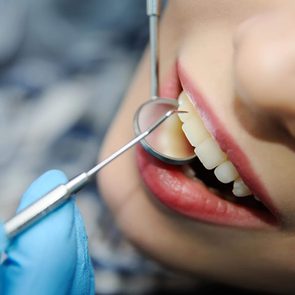Mamelon bumps are ridges on the edges of teeth that don't cause big problems, but can prevent the "perfect smile."
Mamelon Teeth: Dental Experts Explain Why Some of Our Teeth Have Ridges
Mamelons are small, rounded bumps on the edge of permanent, adult incisors (your front teeth) that are a normal part of dental development, explains Cheen Loo, BDS, PhD, MpH, DMD, FAAPD, Chair and Professor of Pediatric Dentistry at the Tufts University School of Dental Medicine. “They are usually three to five rounded edges that resemble a scalloped shell.”
Are mamelons good?
Dr. Loo says that mamelons are most noticeable in children when permanent teeth first erupt—and they tend to wear away and flatten out over time with normal chewing function.
Still, it’s not unusual (or generally cause for concern) for people to have traces of these small ridges past adolescence, adds Shereen S. Azer, BDS, MSc, MS, FACP, Associate Professor and Chair of the Division of Restorative and Prosthetic Dentistry at the Ohio State University College of Dentistry. “There’s no clinical [reason] for removing mamelons,” he says. “In fact, quite often when fabricating porcelain crowns or laminate veneers for anterior teeth, the mamelons are fabricated to show minor traces of them as a sign of beauty and youthful appearance.”
Get The Healthy by Reader’s Digest newsletter
What is the purpose of mamelons?
When teeth develop, small sections called lobes blend and fuse together to form the shape of the crown (the visible part of your tooth), Dr. Azer explains. A mamelon is a rounded bump that results from the merging lobes that form your incisors.
“Although there is no known clinical significance, mamelons may help teeth break through the gums during eruption,” Dr. Loo says. So, like the appendix and other mysterious body parts, it’s unclear if mamelons serve any purpose.

Is it normal to have mamelons as an adult?
Mamelons are most prominent in newly erupted incisors, Dr. Azer explains. “After years of use, they usually are worn down and do not exhibit the same level of prominence compared to childhood due to incisal wear.”
But while they often level out on their own, “It is quite normal, as an adult, to see traces of the lobes.” Past research has shown that about 5% of people have mamelon ridges on their teeth in their 50s—but “trace” mamelons may be much more common.
Are mamelon teeth rare?
Mamelons are a natural result of healthy tooth formation, so almost everyone has them when their permanent teeth grow during childhood. From there, “It’s difficult to identify a specific point in time at which mamelons will wear down,” Dr. Azer says.
Still, normal eating and chewing habits tend to smooth out mamelons by our late teens, says Dr. Loo. (Some behaviors can accelerate typical mamelon wear, such as teeth grinding, biting on nails or ice, or other habits that wear at your enamel, like drinking a lot of soda.) Kelly Privett, DDS, a dentist in Cincinnati, says that 98% of her patients don’t have mamelons beyond the ages of 15 or 16 years old.
Still, if mamelons persist into adulthood, it’s generally due to tooth misalignment. “If these teeth are not properly aligned and do not contact the opposing teeth when chewing, the mamelons may last longer and can be present in adults,” Dr. Loo says. “For example, individuals with an open bite or severe overbite may have mamelons in adulthood.”
Can I fix mamelons?
“When people complain about [mamelon] appearance, it is because they say their teeth look like children’s,” Dr. Privett says. Still, as Dr. Azer explained, cosmetic procedures today sometimes include slight traces of mamelons for a younger appearance. In any case, he says that “They do not present a defect or something to worry about; they are a natural and normal developmental phenomena.”
But if you’re unhappy with how your smile looks, they can easily be filed down by your dentist. The procedure involves contouring and reshaping the edges of these teeth to remove the bumps, Dr. Loo explains. “It is usually painless and does not require anesthesia,” she says. However, when the teeth are contoured, the enamel is removed in a short period of time compared to natural wear of the tooth, which occurs gradually. “Therefore, removing mamelons may cause temporary tooth sensitivity to hot or cold temperatures.”
In very rare cases, Dr. Privett adds, the complete ridges may not be able to be removed, in which case veneers or crowns would be the only solution to solving the purely cosmetic concern.

Do mamelons grow back?
While there’s no reason to remove mamelons, there are no drawbacks or downsides to removing them, either. “If there is a need to remove them and straighten teeth, it is strictly for aesthetic reasons.” Dr. Azer says. “But once gone, mamelons do not grow back because they are essentially traces of the developmental phase of the tooth.”
Are mamelons genetic?
Mamelons themselves aren’t genetic—they’re a natural part of a tooth’s formation. However, retaining these ridges beyond adolescence may have some genetic influence. Research published in 2023 in the Journal of Personalized Medicine says that studies have found specific genes that contribute to open bite development, a type of tooth misalignment that reduces wear and tear on your incisors.
Even if you have a normal bite, other 2023 research published in Genes says that some people are genetically predisposed to having stronger enamel. While this inherited trait is beneficial—stronger enamel reduces the risk of tooth decay, for instance—your teeth will be more resilient to the daily wear and tear that smooths out mamelons. (On the other hand, genetics plays a role in having weaker enamel, too.)
Can mamelons cause a problem?
It can be annoying for small babies to have these bumps on their teeth. But most children and adults have no physical discomfort with mamelons.
According to a 2018 study on oral health in infants published in Pediatrics and Neonatal-Open Journal, the edge of the tooth may have “exaggerated and coarse” ridges that can irritate the underside of the tongue. While parents can watch for this when their babies have new teeth, it isn’t one of the more common teething troubles. And it doesn’t typically bother older kids, either.
About the Experts
|
For more wellness updates, subscribe to The Healthy by Reader’s Digest newsletter and follow The Healthy on Facebook and Instagram. Keep reading:
























